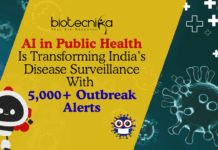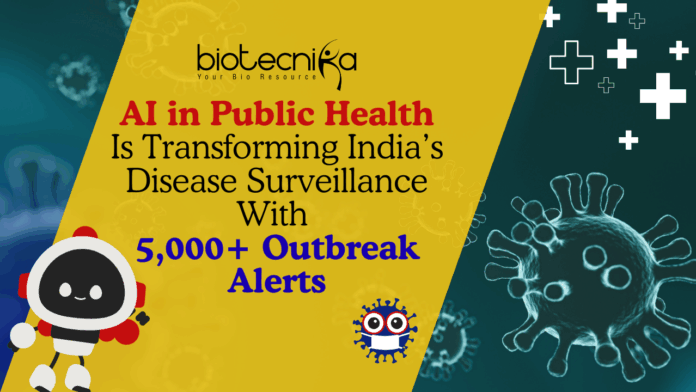AI in Public Health Is Transforming India’s Disease Surveillance With 5,000+ Outbreak Alerts
Healthcare experts face one recurring issue, i.e., how early can an emerging disease or Public Health threat be detected? As discussions around AI in Public Health grow stronger, Researchers are exploring new ways to identify disease outbreaks and patterns sooner.
With disease outbreaks becoming even harder to predict, Scientists and Researchers are looking for new ways to identify patterns sooner and understand risks more clearly. A recent study examines how AI (Artificial Intelligence) & ML (Machine Learning) advancements can support this effort by helping the Research & Healthcare teams analyse health datasets more efficiently and quickly. This rise of AI in healthcare sectors also raises important questions about how such advanced tools and systems could improve health systems’ preparedness as well as strengthen disease monitoring for addressing future challenges worldwide.
India’s disease surveillance network has entered a new advanced horizon, shaped by the growing role of AI in Public Health. It is driven not by human speed but by machine precision and efficacy. A new study has revealed that an AI–powered tool deployed by the NCDC (National Centre for Disease Control) in the year 2022 has indeed strengthened our country’s disease outbreak detection system, identifying thousands of potential health and disease threats with unprecedented accuracy and speed.
The advanced Health tool – “Health Sentinel,” was developed by New Delhi-based Wadhwani AI and has become India’s most essential digital surveillance asset.
Since its installation, it has helped with real-time alerts for more than 5,000 infectious disease outbreaks. This aided healthcare personnel in acting quickly medically and in preventing localised events from escalating into broader Public Health concerns.
A Transformative Leap in India’s Surveillance Capabilities: The Rise of AI in Public Health
“Health Sentinel” has been showcasing a significant impact on disease monitoring in India. According to some reports, implementing this AI system can reduce manual workload by 98%, resulting in a drastic reduction in time spent scanning journals, newspapers, informal sources, and online reports. These advancements have resulted in timely responses by Public Health officials and faster detection of outbreaks in India.
This advanced tool is especially important in the context of the IHR (International Health Regulations), which Legally bind nearly 200 countries across the world to maintain an efficient national disease surveillance system and combat Healthcare concerns.
With the WHO (World Health Organization) working alongside national Healthcare authorities to safeguard global health security, advanced tools such as Health Sentinel are increasingly becoming quite helpful and essential.
How Does this AI Tool Work?
“Health Sentinel” operates by scanning large volumes of online content daily. This system is a practical example of how AI in Public Health can process large volumes of Health information in a short spoan of time and with accuracy.
The advanced AI tools and systems monitor news articles as well as media reports published in 13 different languages across diverse communities and regions in India. Its algorithm identifies unusual health events or syndromic patterns, which are then reviewed by NCDC (National Cooperative Development Corporation) experts for verification and to take further action.
The authors of the study stated, “From April 2022 till date, Health Sentinel has processed over 300 million news articles and identified over 95,000 unique health events across India, of which over 3,500 events (four per cent) were shortlisted by the public health experts at NCDC as potential outbreaks.”
This strong statement highlights the tool’s powerful Analytical capacity, as it can screen millions of reports and identify relevant clusters in a jiffy. This analysis is much faster than human analysts. Despite the advanced and futuristic automation, the system follows a ‘human-in-the-loop’ model, which ensures accuracy in reporting and analysis.
Wadhwani AI’s National Program Lead for Global Health Security, Parag Govil, stated that, even though Artificial Intelligence has replaced manual scanning tasks, Epidemiologists should still conduct proper verification before sending Health alerts to state or district health authorities. This regulated approach balances expert judgement and Technological efficiency.
The Benefits?
One of the most interesting findings in the study is the rise in health event detection since the AI tool’s implementation and actions. The Research team observed a 150% increase in published health events since 2022, compared to years when surveillance relied primarily on manual screening by Healthcare professionals. This reflects the growing importance of AI in Public Health, especially in areas where early signals often go unnoticed through manual processes.
In the year 2024, “Health Sentinel” extracted around 96% of the health events identified by the national surveillance systems, and manual scanning contributed to only 4%. This significant shift showcases the limitations of conventional passive Health reporting systems, which depended mainly on Healthcare professionals and physicians to submit the data. And due to such timely processes, often there were early signals that weren’t detected in advance and resulted in delayed interventions and results.
Evidence from Kerala: How Event-Based Surveillance Helps
The promise of such advanced and futuristic systems was further supported by a separate study published in February in the prestigious journal “Indian Journal of Medical Research,” which is the Official Journal of the Indian Council of Medical Research.
Researchers from the ICMR-NIE (Indian Council of Medical Research-National Institute of Epidemiology) and health teams in Kerala analysed patient records of AFI (Acute Febrile Illness) in six private Hospitals in Kasaragod district.
When the data were analysed, the algorithm identified 88 symptom clusters. Of these 88 clusters, nine were confirmed outbreaks and ten were verified events, including deadly diseases such as COVID-19 and Dengue.
The Research study demonstrated how informal-source and real-time monitoring can uncover health trends way faster and earlier than conventional Health systems and tools.
Researchers from Delhi Technological University expressed that, “The inclusion of online data in surveillance systems has improved the disease prediction ability over traditional syndromic surveillance systems.” This highlights the shift toward digital intelligence as an essential complement to conventional epidemiology.
A Stronger, Smarter Future for India’s Public Health System
“Health Sentinel” exhibits how AI can serve as an enabling force in Public Health across the nation. Its futuristic abilities to rapidly detect anomalies, support expert decision-making, as well as process massive data streams have strengthened India’s Healthcare readiness to respond to emerging disease threats.
By dramatically reducing manual workload and increasing outbreak detection efficiency, the system marks a significant milestone in India’s journey toward modern, resilient Epidemic intelligence.
As infectious disease risks continue to evolve, AI in Public Health will play an even greater role in shaping rapid, informed, and effective responses. Tools like Health Sentinel are expected to play an even bigger role in shaping rapid, informed, and effective Public Health responses, not just in India, but potentially across the world.
India’s newest digital sentinel has proven that when human expertise and Artificial Intelligence work together, the future of disease surveillance becomes sharper, faster, and far more prepared.


























